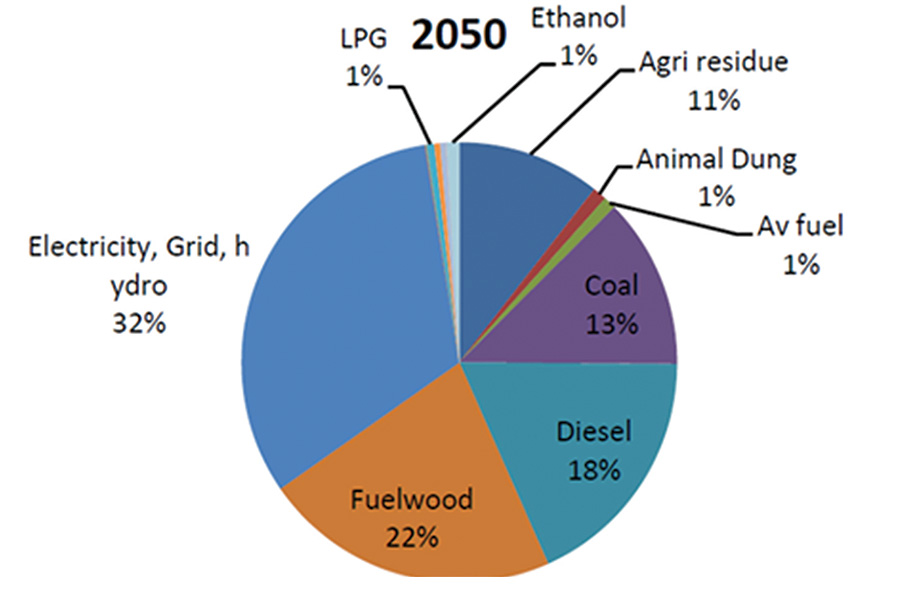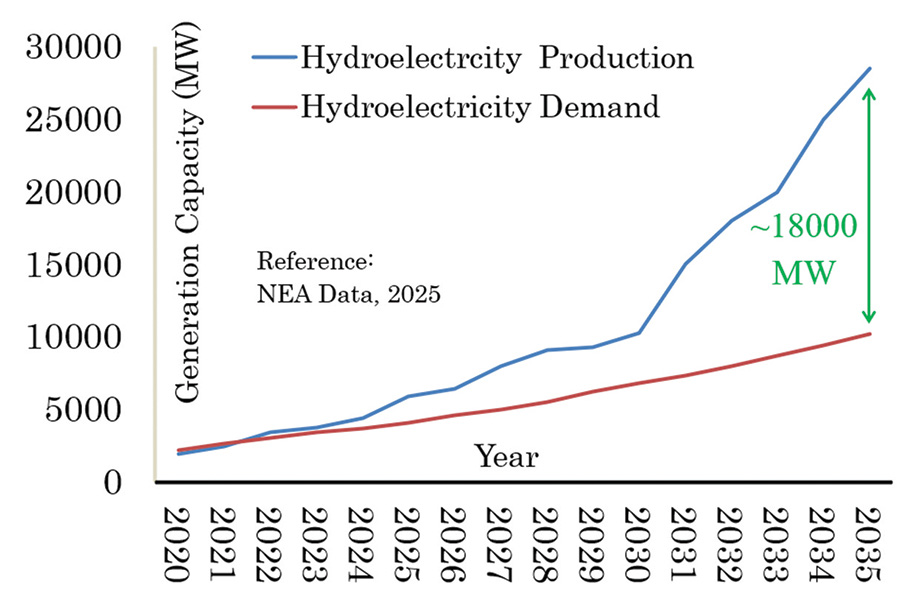
Background
Developed and developing nations alike are increasingly prioritising renewable energy as a strategic response to the adverse impacts of climate change. Projects involving solar, hydropower and wind energy are advancing rapidly across the world. Simultaneously, legal frameworks and policy instruments designed to discourage fossil fuel use and accelerate the adoption of renewable energy are being implemented on a global scale.
Following COP26, most countries have committed to achieving ‘net-zero carbon targets’ and are actively updating and publicising their respective Nationally Determined Contributions (NDCs). Nepal has likewise pledged to reach net-zero carbon emissions by 2045, a target that is more ambitious than those set by the United States and Europe (2050), China (2060) and India (2070).
In this broader international context, Nepal’s strategic response is becoming increasingly evident. To fulfil its climate commitments, Nepal is prioritising the mobilisation of its abundant domestic renewable energy resources. This includes setting ambitious hydropower targets and fast-tracking large-scale solar initiatives as national priorities.
Current Challenge
Nepal’s electricity generation is almost entirely based on renewable sources, with hydropower playing a dominant role. However, when assessed in the context of total energy consumption, the share of electricity remains very low. This highlights the limited integration of renewable electricity within the country’s broader energy mix.
According to data from Fiscal Year 2079/80 (2022/23), fossil fuels made up approximately 25% of Nepal’s total energy consumption, while renewable electricity accounted for only around 7%. Alarmingly, this proportion has remained stagnant in recent years, even as the use of coal and diesel has continued to rise by about 1% annually.
Nepal’s energy policy aims to increase access to reliable and affordable energy, focusing on renewable energy sources and improving energy efficiency. The policy also seeks to reduce reliance on imported fossil fuels and promote sustainable energy practices. Specifically, Nepal is striving to achieve 100% renewable energy by 2050 and increase its installed electric power capacity significantly by 2035. In contradiction a government projection indicates that by 2050, coal and diesel will contribute 13% and 18%, respectively, to Nepal’s overall energy consumption (Fig. 1).

Petrol consumption has been targeted to be replaced by electric vehicles (EVs), especially for short-distance, light-duty transportation. However, diesel remains dominant in heavy-duty transport such as trucks, buses and construction machinery sectors, where electrification is currently less practical. Similarly, coal continues to be widely used in energy-intensive industries like cement, steel and manufacturing. These sectors are considered hard to abate and require deep decarbonisation strategies. In such cases, standard electrification alone is not feasible, making the complete transition away from fossil fuels particularly challenging. In response, targeted interventions, alternative fuels, and advanced technologies will be essential to address these sectors effectively.
The Nepal government has set an ambitious target of generating 28,000 megawatts of hydropower by 2035. If implemented effectively, this plan is expected to produce a surplus of around 18,000 megawatts of electricity that is well beyond the country’s domestic needs (Fig. 2).

This trend poses a dual risk for Nepal. On one hand, it increases the likelihood of the country being pushed toward a ‘coal and diesel-dependent economy’ in the future, and on the other, the underutilisation of domestically generated electricity, along with persistent challenges in exporting it to international markets, is making investments in the hydropower sector increasingly risky.
To address the 100% renewable energy adoption, domestically produced electricity should play a crucial role in displacing hard-to-abate fossil fuels like coal and diesel, thereby contributing to better energy security, energy management, and carbon neutrality. Over the long term, this transition would foster a cleaner energy system and bolster Nepal’s climate resilience. While the global movement to phase out coal and diesel is progressing rapidly, Nepal faces the growing danger of becoming entangled in a fossil fuel trap due to the absence of well-defined policies, regulatory frameworks, and implementable projects.
In response to such challenges, the global community has begun to recognise hydrogen as a strategic alternative for energy transition. In Nepal, coal is primarily used in high-energy-consuming sectors such as the cement industry, brick kilns and heavy manufacturing plants, where combustion processes demand significant energy input. Diesel, by contrast, is mainly consumed by heavy-duty and long-distance transport vehicles.
Although electrifying these systems is technically feasible, Nepal still lacks the necessary strategic planning, investment mechanisms and policy clarity to make meaningful progress.
Hydrogen Technology and the Global Context
In response to the challenges of climate change, a broad-based global consensus is emerging – both at technical and policy levels – around the need to adopt renewable energy as an alternative to fossil fuels. Within this broader shift, technologies that split water into hydrogen and oxygen using renewable energy, and utilise the resulting hydrogen as a clean energy source, are increasingly being recognised as powerful tools for fossil fuel substitution.
Countries with advanced energy systems are progressively adopting technologies that allow for the production of hydrogen at the point of renewable energy generation, wherever and whenever it is available. This hydrogen can then be stored and used as a fossil fuel alternative based on demand, by location, time and purpose. However, hydrogen remains more expensive than conventional fossil fuels and poses significant challenges related to complex storage and safety risks.
Despite these hurdles, hydrogen is gaining attention as a critical bridge technology between fossil fuels and a fully renewable energy future, especially given the present limitations in meeting total energy demand exclusively through renewables. With this in mind, the global technical community is working to make hydrogen technologies more cost-effective, scalable and safe.
At the same time, financial institutions are also beginning to view hydrogen as a credible substitute for fossil fuels. They are developing innovative financial tools, such as climate-resilient business models, integration of carbon credits, and impact-oriented investment mechanisms, to make hydrogen economically viable. Encouragingly, these efforts are beginning to yield positive results.
In this evolving context, Nepal too has taken initial steps to assess and harness the potential of hydrogen technology.
Development of Hydrogen Technology in Nepal
Nepal’s journey in green hydrogen technology formally began in 2020 (2077 BS) under the leadership of Kathmandu University, which initiated early research and coordination efforts. Building on this, in 2021 (2078 BS), the Ministry of Energy established two key expert committees: the Green Hydrogen Coordination Committee and the Green Hydrogen Committee for Fertiliser Production. These bodies conducted comprehensive studies and submitted their findings to the Government of Nepal, laying the groundwork for hydrogen’s formal recognition at the national level. As a direct result, the concept of green hydrogen was included for the first time in Nepal’s annual policy and budget for Fiscal Year 2079/80, signifying its elevation to a national policy priority.
In continuation of this institutional effort, the government formed a green hydrogen related policy drafting committee in 2079 BS. Tasked with developing a national hydrogen policy, the committee undertook broad-based stakeholder consultations, which led to the formulation and official approval of the Green Hydrogen Policy 2080, endorsed by the Council of Ministers. The policy now functions as a strategic roadmap for the institutional development of hydrogen technology in Nepal. It lays out a framework for:
Drafting relevant laws, regulations, procedures and guidelines;Attracting domestic and foreign investment; and Facilitating the implementation of hydrogen projects.
This policy marks a significant step in Nepal’s broader transition toward a sustainable and climate-resilient energy system.
However, the absence of a dedicated hydrogen regulatory authority has posed implementation challenges. In response, Kathmandu University, in collaboration with the government, private sector and international partners, launched the Nepal Hydrogen Initiatives. This initiative envisioned placing Nepal-produced green hydrogen in the global market between 2030 and 2040. Despite its ambition, the initiative was hindered by a lack of enabling infrastructure.
To address this gap, the Ministry of Energy, Water Resources and Irrigation formed a separate committee to study structural arrangements required for effective policy implementation. Ongoing discussions now point toward the growing need for a dedicated regulatory mechanism, such as a Green Hydrogen Development Board, to ensure policy coherence, guide the energy transition, and coordinate execution. Without such an entity, realising Nepal’s full potential in green hydrogen will remain a challenge.
Meanwhile, efforts at the provincial level are also moving forward. Notably, at the 2082 Koshi Province Investment Summit, a Memorandum of Understanding (MoU) was signed between the Koshi Province Government and Green Hydrogen Company Pvt Ltd to prepare a Detailed Project Report (DPR) for a green hydrogen-based fertiliser plant worth Rs 26 billion. This project represents a concrete step forward in operationalising green hydrogen at the sub-national level, aligned with national policy ambitions.
The foundation of Nepal’s green hydrogen proposal lies in the strategic utilisation of its abundant hydropower resources. By harnessing this clean, renewable energy, Nepal aims to pave the way for a green, energy-driven model of industrial development. The core vision is to use domestic renewable energy as a catalyst for establishing an environmentally friendly, sustainable and globally competitive industrial infrastructure.
Hydrogen in the Budget 2082/83: A Strategic Government Priority
Building on its earlier policy commitments, the Government of Nepal has elevated green hydrogen to a strategic priority in its Policy, Programme and Annual Budget for Fiscal Year 2082/83. This latest budget explicitly reaffirms the state’s focus on the development, promotion and institutionalisation of green hydrogen technology. Importantly, it outlines a clear roadmap to attract both domestic and foreign investment for the commercial production of green hydrogen, signalling a proactive shift toward implementation and market readiness.
The government has announced a complete waiver of customs duties and a five-year income tax exemption for the import and production of green hydrogen equipment. This move is widely viewed as a fundamental policy shift that opens the door to private investment in Nepal’s emerging green hydrogen ecosystem.
Key Highlights Related to Green Hydrogen in the Budget of FY 2025/26
Priority on energy self-reliance and promotion of alternative energy.
Reduction of carbon emissions by increasing the production and consumption of alternative energy.
Feasibility studies in collaboration with universities and the private sector.
Attraction of domestic and foreign private investment.
Full tax exemption on the import of machinery and equipment used for green hydrogen production, and a five-year income tax exemption for industries producing green hydrogen.
The government’s decision is being praised as a bold and forward-looking step toward sustainability. The budget also outlines plans to conduct feasibility studies on green hydrogen production in collaboration with universities and the private sector. With this announcement, the government has sent a strong and encouraging signal to both domestic and international investors, positioning green hydrogen as a promising new investment frontier in Nepal’s energy landscape.
The Role Ahead in Institutionalising Hydrogen Development in Nepal
With the aim of contributing to global efforts in mitigating climate change, the Government of Nepal has been prioritising the promotion of renewable energy. In this context, hydrogen technology has recently been given a strategic importance in national policy frameworks, including the annual policy and programme statement as well as the national energy strategy.
The tax holiday announced in this fiscal year’s budget presents a significant opportunity for Nepal to open new avenues for the development and governance of hydrogen technologies. In particular, this tax incentive can play a catalytic role through viability gap financing to scale up hydrogen applications as commercially viable projects, attract investment, and convert them into measurable outcomes, especially in the context of electrification.
At this crucial stage, Nepal must focus on integrating hydrogen into commercialisation, market expansion and industrial applications by actively engaging the private sector. Financial institutions must also be mobilised to support impactful projects through targeted investments, interest rate subsidies, and the adoption of innovative financial instruments.
Moreover, to ensure the technological, economic and financial viability of hydrogen solutions, it is essential to integrate carbon credits generated from fossil fuel displacement. The long-term vision must now include exporting hydrogen and related products to regional and international markets. The next five years represent a critical window to capitalise on hydrogen’s dual-use potential both domestically and globally.
The greatest opportunity, however, lies in the vast potential to electrify Nepal’s internal energy system. Currently, electricity accounts for only 7% of total energy consumption in the country, leaving 93% still to be electrified. From this perspective, hydrogen should be viewed as a structural solution to Nepal’s domestic energy transformation. Developing commercial projects that integrate hydrogen into this system is essential. In this process, the tax exemptions and policy incentives offered in the current budget are expected to play a vital enabling role.
For all these reasons, the time has come to connect hydrogen technology with Nepal’s broader industrial architecture, market frameworks and financial systems to unlock its full potential.
Conclusion
The policy and fiscal incentives for green hydrogen outlined in Nepal’s National Budget for Fiscal Year 2082/83 clearly signal a national commitment toward a clean, sustainable and energy-self-reliant future. Tax exemptions and an investment-friendly environment are expected to pave the way for transforming green hydrogen into commercially viable projects.
However, to fully realise this potential, coordinated efforts among the government, private sector and international partners are essential, along with a clear legal framework and the development of necessary institutional infrastructure. The current policy shift presents an important opportunity to position hydrogen as a central engine in Nepal’s energy transition. The focus must now shift decisively toward practical implementation.




-1763358784.png)

-1758273007.jpg)